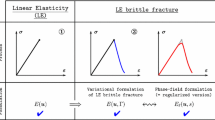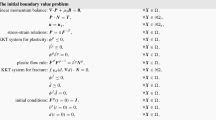Abstract
In this paper, a phase-field model for ductile fracture previously proposed in the kinematically linear regime is extended to the three-dimensional finite strain setting, and its predictions are qualitatively and quantitatively compared with several experimental results, both from ad-hoc tests carried out by the authors and from the available literature. The proposed model is based on the physical assumption that fracture occurs when a scalar measure of the accumulated plastic strain reaches a critical value, and such assumption is introduced through the dependency of the phase-field degradation function on this scalar measure. The proposed model is able to capture the experimentally observed sequence of elasto-plastic deformation, necking and fracture phenomena in flat specimens; the occurrence of cup-and-cone fracture patterns in axisymmetric specimens; the role played by notches and by their size on the measured displacement at fracture; and the sequence of distinct cracking events observed in more complex specimens.























Similar content being viewed by others
References
Besson J (2010) Continuum models of ductile fracture: a review. Int J Damage Mech 19(1):3–52
Trädegard A, Nilsson F, Östlund S (1998) FEM-remeshing technique applied to crack growth problems. Comput Methods Appl Mech Eng 160:115–131
Gurson AL (1977) Continuum theory of ductile rupture by void nucleation and growth: part I—yield criteria and flow rules for porous ductile media. J Eng Mater Technol 99:2–15
Tvergaard V, Needleman A (1984) Analysis of the cup-cone fracture in a round tensile bar. Acta Metall 32:157–169
Lemaitre J (1985) A Continuous damage mechanics model for ductile fracture. J Eng Mater Technol 107:83–89
Lemaitre J (1996) A course on damage mechanics. Springer, New York
Bazant ZP, Pijaudier-Cabot G (1988) Non-local continuum damage. Localization, instability and convergence. J Appl Mech 55:287–294
Peerlings RHJ, De Borst R, Brekelmans WAM, De Vree JHP, Spee I (1996) Some observations on localisation in non-local and gradient damage models. Eur J Mech 15A(6):937–953
Enakoutsa K, Leblond JB, Perrin G (2007) Numerical implementation and assessment of a phenomenological non-local model of ductile rupture. Comput Methods Appl Mech Eng 196(13–16):1946–1957
Reusch F, Svendsen B, Klingbeil D (2003) Local and non-local Gurson-based ductile damage and failure modelling at large deformation. Eur J Mech 22A:779–792
Moës N, Dolbow J, Belytschko T (1999) A finite element method for crack growth without remeshing. Int J Numer Methods Eng 46(1):131–150
Ortiz M, Pandolfi A (1999) Finite-deformation irreversible cohesive elements for three-dimensional crack-propagation analysis. Int J Numer Methods Eng 44(9):1267–1282
Alfano G, Crisfield MA (2001) Finite element interface models for the delamination analysis of laminated composites: mechanical and computational issues. Int J Numer Methods Eng 50:1701–1736
Dimitri R, De Lorenzis L, Wriggers P, Zavarise G (2014) NURBS- and T-spline-based isogeometric cohesive zone modeling of interface debonding. Comput Mech 54:369–388
Scheider I, Brocks W (2003) Simulation of cup-cone fracture using the cohesive model. Eng Fract Mech 70(14):1943–1961
Seabra MRR, Sustarić P, Cesar de Sa JMA, Rodić T (2013) Damage driven crack initiation and propagation in ductile metals using XFEM. Comput Mech 52:161–179
Broumand P, Khoei AR (2013) The extended finite element method for large deformation ductile fracture problems with a non-local damage-plasticity model. Eng Fract Mech 112–113:97–125
Crété JP, Longère P, Cadou JM (2014) Numerical modelling of crack propagation in ductile materials combining the GTN model and X-FEM. Comput Methods Appl Mech Eng 275:204–233
Francfort GA, Marigo JJ (1998) Revisiting brittle fractures as an energy minimization problem. J Mech Phys Solids 46:1319–1342
Bourdin B, Francfort GA, Marigo JJ (2008) The variational approach to fracture. J Elast 91:5–148
Bourdin B, Francfort GA, Marigo JJ (2000) Numerical experiments in revisited brittle fracture. J Mech Phys Solids 48:797–826
Amor H, Marigo JJ, Maurini C (2009) Regularized formulation of the variational brittle fracture with unilateral contact: numerical experiments. J Mech Phys Solids 57:1209–1229
Kuhn C, Müller R (2010) A continuum phase field model for fracture. Eng Fract Mech 77:3625–3634
Miehe C, Hofacker M, Welschinger F (2010) A phase field model for rate-independent crack propagation: robust algorithmic implementation based on operator splits. Comput Methods Appl Mech Eng 199:2765–2778
Borden MJ, Hughes TJR, Landis CM, Verhoosel CV (2014) A higher-order phase-field model for brittle fracture: formulation and analysis within the isogeometric analysis framework. Comput Methods Appl Mech Eng 273:100–118
Ambati M, Gerasimov T, De Lorenzis L (2014) A review on phase-field models of brittle fracture and a new fast hybrid formulation. Comput Mech 55:383–405
Duda FP, Ciarbonetti A, Sanchez PJ, Huespe AE (2014) A phase-field/gradient damage model for brittle fracture in elastic-plastic solids. Int J Plast 65:269–296
Borden MJ (2012) Isogeometric analysis of phase-field models for dynamic brittle and ductile fracture. PhD dissertation, The University of Texas at Austin
Miehe C, Hofacker M, Schänzel L, Aldakheel F (2014) Phase field modeling of fracture in multi-physics problems. Part II. Coupled brittle-to-ductile failure criteria and crack propagation in thermo-elastic-plastic solids. Comput Methods Appl Mech Eng 294:486–522
Ambati M, Gerasimov T, De Lorenzis L (2015) Phase-field modeling of ductile fracture. Comput Mech 55:1017–1040
Alessi R, Marigo JJ, Vidoli S (2014) Gradient damage models coupled with plasticity and nucleation of cohesive cracks. Arch Ration Mech Anal 214:575–615
Alessi R, Marigo JJ, Vidoli S (2015) Gradient damage models coupled with plasticity: variational formulation and main properties. Mech Mater 80:351–367
Wick D, Wick T, Hellmig RJ, Christ HJ (2015) Numerical simulations of crack propagation in screws with phase-field modeling. RICAM-Report No. 2015–11
Miehe C, Schänzel LM (2014) Phase field modeling of fracture in rubbery polymers: part I: finite elasticity coupled with brittle failure. J Mech Phys Solids 65:93–113
Hesch C, Weinberg K (2014) Thermodynamically consistent algorithms for a finite-deformation phase-field approach to fracture. Int J Numer Methods Eng 99:906–925
Clayton JD, Knap J (2014) A geometrically nonlinear phase field theory of brittle fracture. Int J Fract 189:139–148
Mesgarnejad A, Bourdin B, Khonsari MM (2015) Validation simulations for the variational approach to fracture. Comput Methods Appl Mech Eng 290:420–437
Xiao H, Bruhns OT, Meyers A (2006) Elastoplasticity beyond small deformations. Acta Mech 182:31–111
Naghdi PM (1990) A critical review of the state of finite plasticity. J Appl Math Phys 41:315–394
Simo JC (1988) A framework for finite strain elastoplasticity based on maximum plastic dissipation and the multiplicative decomposition. Part I: continuum formulation. Comput Methods Appl Mech Eng 66:199–219
Simo JC, Hughes TJR (1998) Computational inelasticity. Springer, New York
Holzapfel GA (2000) Nonlinear solid mechanics. Wiley, Chichester
Voce E (1955) A practical strain hardening function. Metallurgia 51:219–226
Simo JC (1988) A framework for finite strain elastoplasticity based on maximum plastic dissipation and the multiplicative decomposition. Part II: computational aspects. Comput Methods Appl Mech Eng 68:1–31
Guo J, Zhao S, Murakami R, Zang S (2013) Experimental and numerical investigation for ductile fracture of Al-alloy 5052 using modified Rousselier model. Comput Mater Sci 71:115–123
Simo JC, Rifai MS (1990) A class of mixed assumed strain methods and the method of incompatible modes. Int J Numer Methods Eng 29:1595–1638
Simo JC, Armero F (1992) Geometrically non-linear enhanced strain mixed methods and the method of incompatible modes. Int J Numer Methods Eng 33:1413–1449
Hughes TJR (1980) Generalization of selective integration procedure to anisotropic and nonlinear media. Int J Numer Methods Eng 15:1413–1418
Hughes TJR (2000) The finite element method: linear static and dynamic finite element analysis. Dover Publications, Mineola
Simo JC, Taylor RL, Pister KS (1985) Variational and projection methods for the volume contraint in finite deformation elastoplasticity. Comput Methods Appl Mech Eng 51:177–208
de Souza Neto EA, Peric D, Dutko M, Owen DRJ (1996) Design of simple low order finite elements for large strain analysis of nearly incompressible solids. Int J Solids Struct 33:3277–3296
Elguedj T, Bazilevs Y, Calo VM, Hughes TJR (2008) B-bar and F-bar projection methods for nearly incompressible linear and non-linear elasticity and plasticity based on higher-order NURBS elements. Comput Methods Appl Mech Eng 197:2732–2762
Elguedj T, Hughes TJR (2014) Isogeometric analysis of nearly incompressible large strain plasticity. Comput Methods Appl Mech Eng 268:388–416
Tvergaard V, Needleman A (1984) Analysis of the cup-cone fracture in a round tensile bar. Comput Methods Appl Mech Eng 32:157–169
Bao Y, Wierzbicki T (2004) On fracture locus in the equivalent strain and stress triaxiality space. Int J Mech Sci 46:81–98
Wierzbicki T, Bao Y, Lee YW, Bai Y (2005) Calibration and evaluation of seven fracture models. Int J Mech Sci 47:719–743
Mediavilla J, Peerlings RHJ, Geers MGD (2006) Discrete crack modelling of ductile fracture driven by non-local softening plasticity. Int J Numer Methods Eng 66(4):661–688
Xue L (2007) Damage accumulation and fracture initiation in uncracked ductile solids subject to triaxial loading. Int J Solids Struct 44:5163–5181
Boyce BL (2014) The Sandia fracture challenge: blind round robin predictions of ductile tearing. Int J Fract 186:5–68
Guo J (2013) An experimental and numerical investigation on damage evolution and ductile fracture mechanism of aluminum alloy. PhD dissertation, The University of Tokushima
Gerasimov T, De Lorenzis L (subm.) A line-search assisted monolithic approach for phase-field computing of brittle fracture
Acknowledgments
This research was funded by the European Research Council, ERC Starting Researcher Grant INTERFACES, Grant Agreement No. 279439.
Author information
Authors and Affiliations
Corresponding author
Rights and permissions
About this article
Cite this article
Ambati, M., Kruse, R. & De Lorenzis, L. A phase-field model for ductile fracture at finite strains and its experimental verification. Comput Mech 57, 149–167 (2016). https://doi.org/10.1007/s00466-015-1225-3
Received:
Accepted:
Published:
Issue Date:
DOI: https://doi.org/10.1007/s00466-015-1225-3




